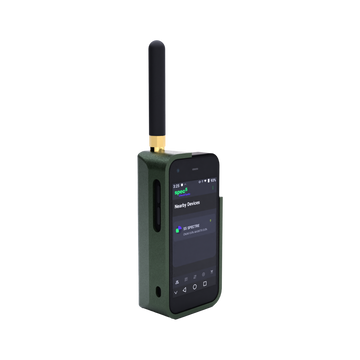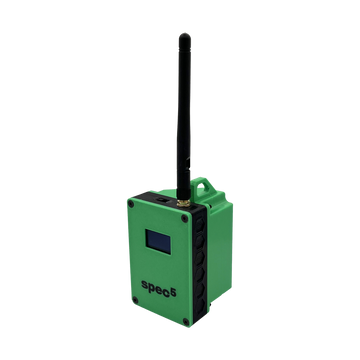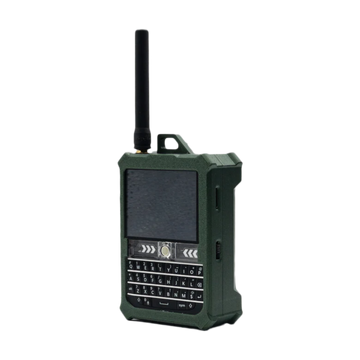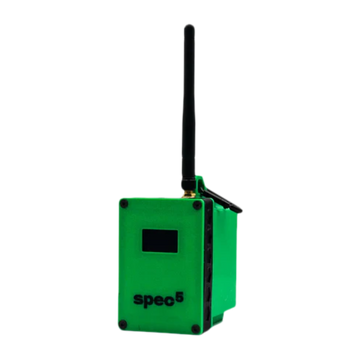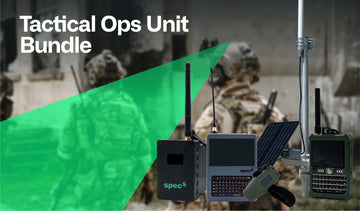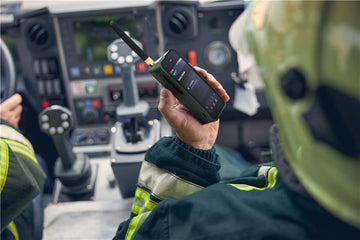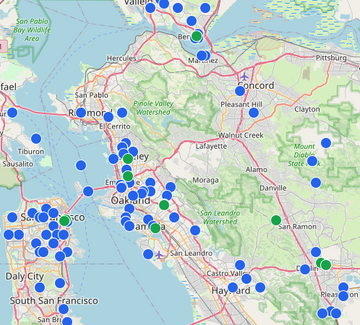1. Introduction
Modern logistics operations increasingly face scenarios where traditional communication infrastructure is absent, degraded, or untrusted. Natural disasters disrupt cellular towers. Military operations extend beyond commercial network coverage. Humanitarian deployments reach remote areas where connectivity was never established. In these environments, the fundamental question of "where are my assets?" becomes extraordinarily difficult to answer.
Satellite-based tracking solutions exist but carry significant tradeoffs. They require line-of-sight to orbital assets, involve recurring subscription costs, consume substantial power, and typically operate on proprietary systems with vendor lock-in. Cellular IoT solutions like NB-IoT or LTE-M require functioning base stations, which are precisely what disconnected environments lack.
The logistics gap is real: organizations need to track supplies, vehicles, and equipment in environments where neither cellular nor satellite connectivity can be relied upon. This whitepaper examines how LoRa mesh networking addresses this challenge, with specific focus on real-world deployment patterns already proven in disaster relief operations.
2. Why Mesh for Logistics?
Mesh networking operates on fundamentally different principles than traditional hub-and-spoke communication architectures. In a mesh topology, each node functions simultaneously as an endpoint and a relay. When one node needs to communicate with another beyond its direct radio range, intermediate nodes automatically forward the message through the network.
LoRa (Long Range) modulation provides the physical layer for these mesh networks, operating in unlicensed ISM bands (typically 915 MHz in North America, 868 MHz in Europe). LoRa's key advantage lies in its link budget—the combination of transmit power and receiver sensitivity that determines maximum communication range. High receiver sensitivity (typically -137 dBm to -148 dBm depending on spreading factor) allows LoRa radios to decode extremely weak signals, enabling long-distance communication at relatively low transmit power. Under favorable conditions, node-to-node communication can extend 5-10 kilometers in open terrain, though practical deployments in varied topography typically plan for 1-3 kilometer reliable ranges.
For logistics applications, mesh networking offers several technical advantages:
- Infrastructure independence: The network exists solely among deployed nodes. No external infrastructure is required for basic operations, though internet gateways can be integrated when beneficial.
- Self-healing topology: If a relay node fails or moves out of range, the mesh protocol automatically recalculates routes through remaining nodes. This resilience is critical when operating in dynamic or hostile environments.
- Scalable density: Additional nodes strengthen rather than congest the network (up to protocol-specific limits). More nodes mean more relay paths and improved coverage depth.
- Power efficiency: LoRa's low duty cycle and efficient modulation allow battery-powered nodes to operate for months or years, depending on transmission frequency and power settings.
SpecFive's approach centers on open-source firmware (primarily Meshtastic) running on purpose-built hardware. This combination provides transparency into network behavior, allows field-level configuration flexibility, and avoids proprietary protocol lock-in. The mesh routing logic is implemented within the Meshtastic firmware itself—this is distinct from LoRaWAN, which uses a star topology with centralized gateways. In Meshtastic's architecture, each node makes routing decisions based on its local view of the network, forwarding packets toward their destination through available paths. When mesh traffic needs to reach IP networks, internet-connected gateway nodes bridge Meshtastic packets to MQTT or other protocols, enabling integration with cloud services or command centers.
3. SpecFive Trace XR: Purpose-Built for Field Logistics
The Trace XR represents a specific engineering solution to a defined problem: how do you track mobile assets in off-grid environments with minimal power consumption and maximum durability?
Hardware specifications relevant to deployment planning:
- GNSS receiver with support for GPS, GLONASS, and Galileo constellations
- LoRa radio (915 MHz) with configurable spreading factors (SF7-SF12)
- Lithium battery system with multi-month operational life
- IP67-rated enclosure suitable for airdrop impact and environmental exposure
- Compact form factor designed for mounting on crates, vehicles, or equipment
- Solar charging capability for extended deployments
Operational characteristics:
The Trace XR captures location coordinates from GNSS satellites and transmits position updates via LoRa mesh at configurable intervals (typically 2-15 minutes depending on mission requirements). These position packets include latitude, longitude, altitude, timestamp, and battery status. The device operates autonomously once configured—no user interaction is required during deployment.
Transmission power and spreading factor can be adjusted for range versus power consumption tradeoffs. Higher spreading factors (SF10-SF12) provide greater range at the cost of longer airtime and increased power draw. Field deployments typically configure devices at SF10 or SF11 to balance robustness against interference with reasonable battery life.
Real-world validation: California Air National Guard
The Trace XR is not a prototype system. The California Air National Guard currently deploys Trace XR units on supply crates during disaster relief airdrops. When wildfires, earthquakes, or other emergencies create urgent supply needs in areas without intact infrastructure, aircraft drop palletized supplies with Trace XR units mounted directly on the cargo.
Ground teams carry mesh-enabled receivers (SpecFive Trekker (Delta or Bravo ) that display the location of landed crates on digital maps. This application directly addresses a persistent problem in airdrop operations: precise delivery is difficult, and supplies that cannot be located cannot be distributed. Wind, terrain, and visibility conditions all contribute to uncertainty about landing zones.
By equipping each crate with location-transmitting capability that functions independently of any existing infrastructure, recovery teams can navigate directly to supplies rather than conducting time-consuming search patterns. This is not theoretical efficiency—it translates to hours saved in time-critical disaster response.
4. How It Works: Near Real-Time Tracking with Mesh
Understanding what "real-time tracking" means in a mesh context requires clarity about the underlying mechanism and its constraints.
Step-by-step operation:
- Location acquisition: The Trace XR's GNSS receiver acquires signals from positioning satellites (GPS, GLONASS, Galileo) to calculate its current coordinates. This process requires clear sky view and typically completes within 30-120 seconds of power-on (cold start) or 5-30 seconds for subsequent fixes.
- Position packet creation: The device packages location data (latitude, longitude, altitude, timestamp) along with device ID and battery status into a compact data structure, typically 40-80 bytes.
- LoRa transmission: The Trace XR transmits this packet via LoRa radio. The transmission propagates in all directions from the device.
- Mesh relay: Any mesh node within radio range (1-5 kilometers depending on terrain, antenna height, and radio configuration) receives the packet. If that node is the intended destination (e.g., a handheld receiver carried by a search team), the location displays on a map interface. If the receiving node is an intermediate relay, it automatically retransmits the packet to extend its reach through the network.
- Gateway bridging (optional): If a mesh gateway node with internet connectivity is within the mesh network, position data can be forwarded to cloud services or command centers. This enables remote monitoring even when command staff are not physically within the mesh network.
Critical limitation: mesh reachability requirement
GPS/GNSS positioning and mesh networking serve distinct functions that must not be conflated. The Trace XR's GNSS receiver allows the device to know where it is. The LoRa mesh radio allows the device to communicate that information to other nodes.
If a Trace XR lands or moves beyond the range of all other mesh nodes, it will continue to log its position internally, but no real-time tracking occurs because there is no communication path. The device has location data, but that data cannot propagate to operators until mesh connectivity is re-established.
This is not a flaw—it is an inherent characteristic of mesh networking. A mesh network only functions when nodes maintain connectivity to at least one other node. Isolated devices cannot communicate by definition.
Practical implications for deployment:
- Tracking is "near real-time" only within the connected mesh network
- Asset recovery teams must be within mesh range (directly or via relay nodes) to receive location updates
- Strategic placement of relay nodes extends effective tracking coverage
- For airdrop scenarios, either ground teams must be nearby or relay nodes must be deployed to bridge coverage gaps
Range considerations:
- Open terrain, elevated antennas: 3-5 km typical
- Urban or forested environments: 500m-2 km typical
- Mountain valleys: highly variable, 100m-3 km depending on line of sight
- Building interiors: 50-200m typical
5. Example Deployment: Disaster Relief Airdrops
The California Air National Guard deployment demonstrates how mesh-based tracking integrates into operational workflows.
Pre-deployment configuration:
- Trace XR units are configured for 30 seconds position update intervals, SF11 spreading factor, and maximum transmission power.
- Each device is associated with a unique identifier and assigned to specific cargo pallets.
- Devices are mounted in protective cases affixed to the exterior of pallets for optimal GNSS and radio performance.
Airdrop execution:
Aircraft drop palletized supplies into designated landing zones. Due to wind, altitude, and other variables, actual landing positions scatter around the intended target.
Ground recovery:
Recovery teams arrive in the general area carrying SpecFive Ranger or Trekker (Delta/Bravo) devices—rugged handheld units with mesh capability, GNSS, and mapping interfaces. As teams enter mesh range of the dropped supplies (typically within 1-3 km in disaster terrain), they begin receiving position updates from Trace XR units.
The mapping interface displays each Trace XR's location, distance, and bearing. Teams navigate directly to pallets using real-time position data rather than visual search patterns. As teams move through the area, their own devices serve as mobile relays, extending mesh coverage and enabling other teams to receive updates from more distant pallets.
Extended scenarios:
- Vehicle-mounted relay nodes extend coverage as ground vehicles patrol or stage in the area
- Drone-mounted relays provide temporary elevated coverage for rapid area surveys
- Stationary relay nodes (SpecFive Relay units) positioned on high ground or buildings create persistent coverage zones
- Internet-connected gateways at forward operating bases bridge mesh traffic to command centers for remote monitoring
6. Best Practices for Field Deployment
- Calculate expected mesh coverage based on terrain and intended relay placement. Avoid scenarios where tracked assets might land or travel beyond all mesh node range.
- Position gateways at the edge of mesh coverage near areas with intact cellular service.
- Use satellite internet terminals for gateway backhaul when terrestrial options are unavailable.
- Adjust configuration parameters based on mission profiles.
- Mount Trace XR units with antenna clear of metal objects and dense materials.
- Orient devices for sky view (GNSS performance) and horizontal radio propagation.
- Walk or drive through intended operational area with test devices to validate actual range.
7. Limitations and Considerations
What mesh-based tracking does well:
- Enables asset location visibility in environments with no cellular or satellite infrastructure
- Operates independently of external services or subscriptions
- Provides local coordination capability for distributed teams
- Scales effectively for moderate density deployments
- Offers multi-month battery life with appropriate configuration
What mesh-based tracking cannot do:
- Does not provide global visibility—tracking only functions within mesh network range
- Cannot track assets that move beyond all mesh node connectivity
- Does not offer direct-to-satellite communication
- Limited by radio propagation constraints
- Not suitable for real-time tracking of rapidly moving assets across large areas without extensive relay infrastructure
Appropriate use cases:
- Assets remain within relatively bounded areas
- Recovery teams or relay infrastructure can be positioned to maintain mesh connectivity
- Cellular and satellite options are unavailable or undesirable
- Multi-month autonomous operation is required
- Equipment must withstand harsh environmental conditions
Inappropriate use cases:
- Assets may travel hundreds of kilometers beyond any possible relay infrastructure
- Immediate global visibility is required
- Real-time tracking of high-speed assets across continental distances
- Mesh node density cannot be maintained due to operational constraints
Spectrum and regulatory considerations:
- Devices must comply with duty cycle restrictions
- Multiple organizations share spectrum—coordination may be needed
- Interference from other LoRa devices can impact reliability
- Different regulatory regimes apply in different countries
Security considerations:
- Encryption can be enabled for position data and messaging (AES-256)
- Network segmentation via channel configuration limits who receives what data
- RF transmissions are inherently detectable—operational security may require consideration of emissions control
- Physical security of devices matters—captured devices could reveal network configuration
8. Conclusion
Mesh-based asset tracking via LoRa networking addresses a genuine operational gap. Organizations conducting logistics in disconnected environments face real challenges that cellular and satellite solutions do not adequately solve—either due to infrastructure unavailability, cost constraints, power limitations, or operational security requirements.
The SpecFive Trace XR and similar mesh-enabled tracking devices provide a field-proven approach. The California Air National Guard's deployment for disaster relief airdrops demonstrates practical utility: supplies that cannot be found cannot be distributed, and mesh-based location sharing directly solves this problem in environments where traditional tracking fails.
However, effectiveness depends on deployment discipline. Mesh networks require connectivity to function. Organizations must plan relay infrastructure, account for terrain effects on radio propagation, and configure devices appropriately for mission requirements. This is not plug-and-play technology—it requires understanding of radio fundamentals and thoughtful operational planning.
The value proposition is straightforward: when deployed correctly, mesh tracking provides asset visibility in scenarios where alternatives are nonviable. This is not revolutionary technology—it is pragmatic application of proven radio techniques to operational problems. The Air National Guard uses it because it works when properly implemented, not because it performs miracles.
For organizations evaluating mesh-based tracking, the critical questions are not about theoretical capabilities but practical deployment scenarios: Can you maintain mesh connectivity to your assets? Can you position relay nodes or recovery teams appropriately? Do you have personnel who understand radio propagation and network configuration? If yes, mesh tracking offers a robust solution. If no, other approaches may be more suitable.
SpecFive's focus on rugged, field-serviceable hardware running open-source firmware reflects a philosophy: operators should understand their tools, not blindly trust black boxes. Mesh networking is not magic—it is physics, protocol design, and careful engineering. When those elements align with operational requirements, the results are reliable, infrastructure-independent asset tracking that functions precisely when and where it is needed most.
About SpecFive
SpecFive develops rugged, solar-powered mesh networking devices for off-grid communication and asset tracking. Products run open-source firmware (Meshtastic) on purpose-built hardware designed for extended field deployment in harsh environments. For technical specifications, deployment guidance, or case study information: contact us.

